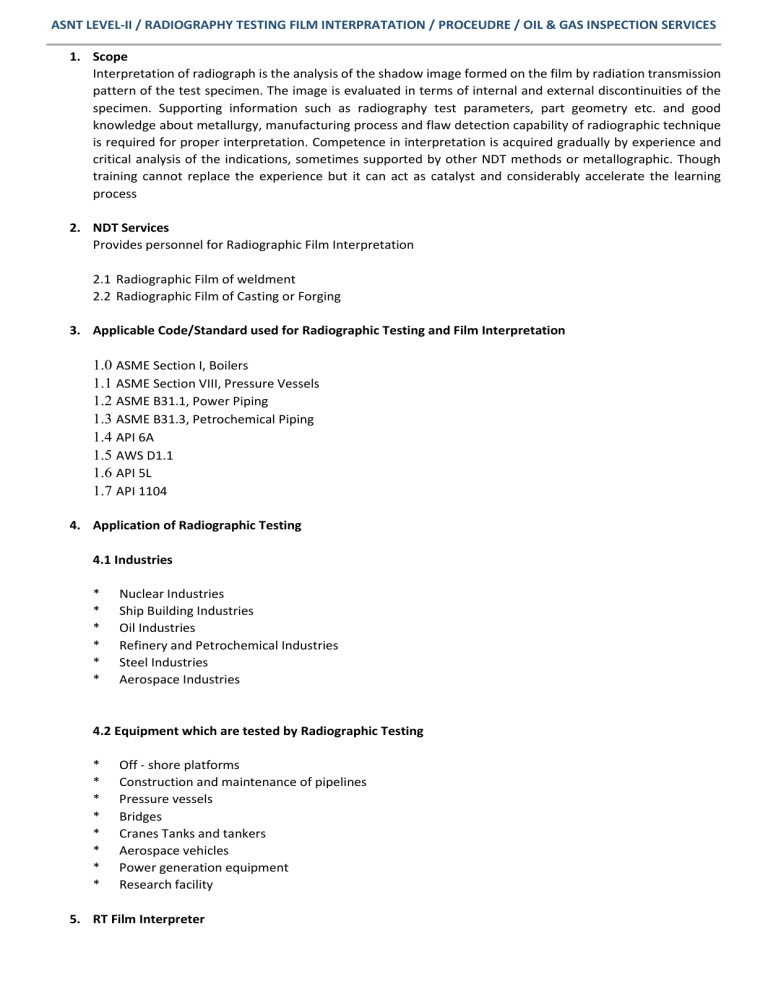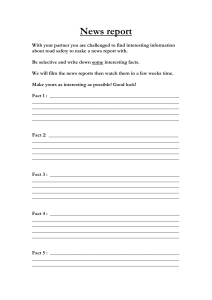
ASNT LEVEL-II / RADIOGRAPHY TESTING FILM INTERPRATATION / PROCEUDRE / OIL & GAS INSPECTION SERVICES 1. Scope Interpretation of radiograph is the analysis of the shadow image formed on the film by radiation transmission pattern of the test specimen. The image is evaluated in terms of internal and external discontinuities of the specimen. Supporting information such as radiography test parameters, part geometry etc. and good knowledge about metallurgy, manufacturing process and flaw detection capability of radiographic technique is required for proper interpretation. Competence in interpretation is acquired gradually by experience and critical analysis of the indications, sometimes supported by other NDT methods or metallographic. Though training cannot replace the experience but it can act as catalyst and considerably accelerate the learning process 2. NDT Services Provides personnel for Radiographic Film Interpretation 2.1 Radiographic Film of weldment 2.2 Radiographic Film of Casting or Forging 3. Applicable Code/Standard used for Radiographic Testing and Film Interpretation 1.0 ASME Section I, Boilers 1.1 ASME Section VIII, Pressure Vessels 1.2 ASME B31.1, Power Piping 1.3 ASME B31.3, Petrochemical Piping 1.4 API 6A 1.5 AWS D1.1 1.6 API 5L 1.7 API 1104 4. Application of Radiographic Testing 4.1 Industries * * * * * * Nuclear Industries Ship Building Industries Oil Industries Refinery and Petrochemical Industries Steel Industries Aerospace Industries 4.2 Equipment which are tested by Radiographic Testing * * * * * * * * Off - shore platforms Construction and maintenance of pipelines Pressure vessels Bridges Cranes Tanks and tankers Aerospace vehicles Power generation equipment Research facility 5. RT Film Interpreter ASNT LEVEL-II / RADIOGRAPHY TESTING FILM INTERPRATATION / PROCEUDRE / OIL & GAS INSPECTION SERVICES 1.0 Radiographic Interpreter shall possess a current certificate of Proficiency in Radiography Level II, Level III or Radiographic Interpreter to a recognized qualification and certification scheme from approved training centers 6. Preparation Radiographic Inspection shall only be carried out on weldment which has visually inspected and any remedial work necessary is completed and accepted by the customer. In addition, the Radiographer inspects the weld surface for any irregularities that may mask or confuse interpretation of the final radiograph 7. Location of Datum All weld will be positively marked datum and each portion under examination shall be positively identified by marking along the length of the weld. This may be achieved by taking measurements along the length of the weld from an agreed datum. For tubular structure, the ‘clock face’ method shall be employed and the datum line shall be positioned, as follows: 7.1 For horizontal and inclined tubular structure, the datum is the highest point in the joint when viewed from the lower numbered joint 7.2 For vertical tubular structure, the datum is north when the joint is viewed vertically downwards 8. Justification In all cases the datum shall be indelibly marked on the welds. A meter band incorporating lead numerals along the welds shall be utilized to allow positive location of any discontinuity 9. Film 1.0 Type of film Radiographs shall be made using industrial radiographic film and shall be selected from Table 1 below. Table 1: Selection of Radiographic Film CLASS OF FILM I (High sensitive film) II (Sensitive film) BRAND TYPE Dupond NDT 55 Agfa D4 Kodak MX Dupond NDT 70 Agfa D7 Kodak CX Films shall have sufficient length and shall be placed to produce at least 13mm of film exposed to direct radiation beyond each free edge where the weld is terminated 9.2 Overlap If more than one films are required in single exposure, overlapping cassettes shall be used. Radiographs shall have 25mm overlap at each end to ensure that no portion of the joint remains unexamined. There shall be a specific lead marker visible on both radiographs in overlap ASNT LEVEL-II / RADIOGRAPHY TESTING FILM INTERPRATATION / PROCEUDRE / OIL & GAS INSPECTION SERVICES 10. Screens Lead intensifying screens shall be used. The front screen thickness shall normally be 0.125mm and the rear will normally be 0.125mm Screen shall be examined on a regular basis for dirt or blemishes which may transfer onto the film thus causing confusion with and masking of defect images 11. Geometric Relationships 11.1 The geometric unsharpness is calculated as follows: Geometric unsharpness, Where : Ug = f x d s-d f is the Focal Spot Size of Source Size d is the Object-to-Film Distance s is the Focal spot-to-Film Distance (X-ray) or source-to-film distance (Gamma Ray) 11.2.1 Geometric Unsharpness of the radiograph shall not exceed the Ug value in Table 2 below: Table 2: Maximum Geometric Unsharpness MATERIAL THICKNESS, mm Ug MAXIMUM, mm Under 50.8 0.51 50.8 through 76.2 0.76 50.9 Over 76.2 through 101.6 1.02 50.10 Greater than 101.6 1.78 Material thickness is the thickness on which the penetrameter is based. This shall be the base metal or parent metal plus the maximum allowable reinforcement. For welds at transition thickness, material thickness shall be the thinner base metal 12. Image Quality Indicators (IQI) 12.1 Selection of IQI The IQI provides a guide to the quality of radiographs produced and shall be appropriately chosen from one of the types recommended in DIN 54109 (Table 3) Table 3: DIN 54109 Wire Type IQI Designation Penetrameter Wire Wire Designation Number Diameter, mm 1 3.200 2 2.500 3 2.000 4 1.600 5 1.250 1-7 ASNT LEVEL-II / RADIOGRAPHY TESTING FILM INTERPRATATION / PROCEUDRE / OIL & GAS INSPECTION SERVICES 6 - 12 10 - 16 12.2 6 1.000 7 0.800 6 1.000 7 0.800 8 0.6300 9 0.500 10 0.400 11 0.320 12 0.250 10 0.400 11 0.320 12 0.250 13 0.200 14 0.160 15 0.125 16 0.100 Source Side Penetrameter(s) The penetrameter(s) shall be placed on the source side of the part being examined 12.3 Film Side Penetrameter(s) Where inaccessibility prevents, hand placing the penetrameter(s) on the source side it shall be placed on the film side in contact with the part being examined. A lead letter ‘F’ at least as high as the penetrameter identification number(s) shall be placed adjacent to the penetrameter(s) 12.3.1 Radiography shall be performed with a technique of sufficient sensitivity to display the penetrameter image and the designated or smallest wire for required sensitivity which are essential indications of the image quality of the radiograph. The radiographs shall also display the identifying number and letters 13. Number of Penetrameter IQI shall show clearly on each radiograph. For a radiograph represents 255mm or greater of weld length, two IQI shall be placed; one at each end of the weld length. For radiograph represents less than 255mm of weld length, one IQI shall be placed at any end of the weld length. IQI shall be perpendicular to the joint with the smallest wire on the outer edge of the area being radiographed Figure 1 and Figure 2 illustrate the arrangement of IQI(s) locations. For tubular structure, the following exception minimum number and required locations of IQI shall be followed: - ASNT LEVEL-II / RADIOGRAPHY TESTING FILM INTERPRATATION / PROCEUDRE / OIL & GAS INSPECTION SERVICES 13.1 Where the source is located at the center of the tubular structure and one or more film holders are used for a single exposure of complete circumference (Panoramic Technique), at least three penetrameter shall be spaced approximately 120 apart 13.2 Where the source is placed at the center of the component (Single-Wall Single-Image Viewing) and four or more film holders are used for a single exposure of a section of the circumference, at least three penetrameter shall be used. One penetrameter shall be in the approximate center of the section exposed and one at each end 13.3 Where the source is located on the axis of the object (Double-Wall Single-Viewing Technique) and four or more film holders are used for an exposure of a circumferential weld, at least three penetrameter shall be used. One penetrameter shall be in the approximate center of the section exposed and one at each end 14. Sensitivity The required sensitivity for each radiograph using DIN 54109 Wire IQI is as per ASME V Table T-276. DIN 54109 Wire Type IQI Sensitivity is calculated using the following formula: IQI Sensitivity = Diameter of Thinnest Wire Visible on Radiograph x 100% Thickness of Penetrated Material in Same Region 15. Film Density For each radiograph made, film Density will be measured in interest and shall be not less than 1.8 and not greater than 4.0 in density 16. Viewing Conditions The radiographs shall be examined in a darkened room. The radiograph viewer shall provide a light source sufficient for the essential IQI wire/hole to be visible for the specific density range. The light from around the outer edges of the radiographs will be masked 17. Interpretation of Radiographs A calibrated densitometer or calibrated density strip will be kept near the viewer and a ‘spot’ high density illuminator will be available. All comments about film quality and interpretation will be recorded on the film folder and on the radiographic report form The density of density strips and densitometer calibration shall be verified by comparison with a calibrated step wedge film traceable to a national standard. The densitometer shall be calibrated in accordance with paragraph 5 of ASTM E-1079, Calibration of Transmission Referencing Code section



